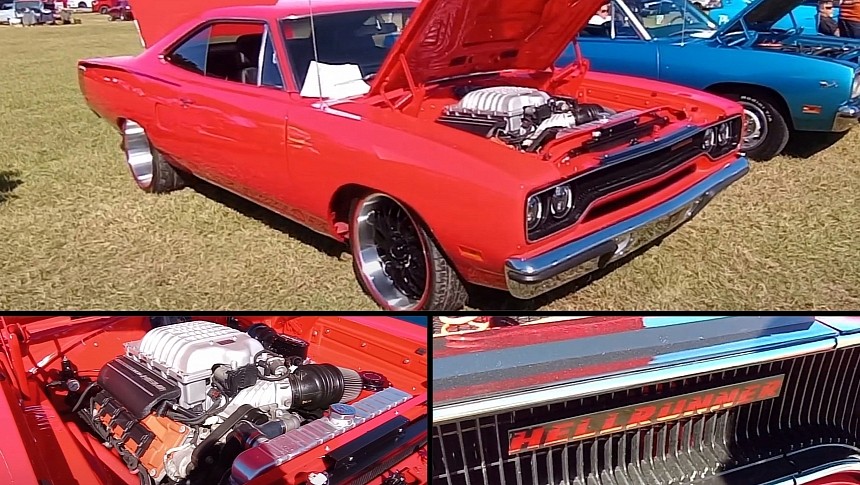While not quite as fancy as the GTX, the Plymouth Road Runner was one of the greatest muscle cars of the golden era. Available with Chrysler's biggest V8 engines, it was the most affordable way into HEMI ownership, just like the Dodge Super Bee.
The Road Runner was notably more popular than the GTX and the Super Bee. It sold 44,303 units in 1968, a whopping 81,105 examples in 1969, and 36,861 cars in 1970. Sales dived in the early 1970s, but that was a trend for the entire muscle car segment. By the time it was discontinued in 1974, the Road Runner had moved more than 200,000 units.
However, only a tiny fraction of them left the factory with the mighty 426-cubic-inch (7.0-liter) HEMI V8. Offered from 1968 through 1971, the HEMI found its way into only 2,003 vehicles. That's less than 1% of the total production and a figure that makes the HEMI Road Runner a super rare gem.
The 440-cubic-inch (7.2-liter) Six Pack cars aren't exactly common either. Offered for only three model years (1969-1971), the 390-horsepower RB unit powered just 3,473 Road Runners. But the HEMI remains the number one choice of Mopar gearheads willing to spend more than $100,000 (or even $200,000) for a golden-era classic.
On the flip side, you don't really need a HEMI to enjoy a powerful Mopar of the "beep-beep" variety. And no, I'm not talking about the smaller 383-cubic-inch (6.3-liter) V8, which was reasonably potent at 335 horsepower. The Road Runner's engine bay is large enough to accommodate a modern Hellcat lump. That's right, we're going into restomod territory with this one.
Now, I can fully understand if you're not into this type of thing. I agree that classic muscle cars are best preserved as original as possible. However, an engine swamp is a solid option when the vehicle in question was saved from a barn in poor condition. If you pump a lot of cash into fixing (or almost replacing) a rotting carcass, you might as well go all-in with a modern powerplant.
That's precisely what one Road Runner owner did, and he showcased the result at the 2023 Mopars with Big Daddy. And it's quite a stunning build that flexes a spotless, bright red finish and rides on larger-than-usual rims wrapped in low-profile tires.
Mods also include modern LED headlamps and tailights, custom Hellcat stripes on the rear fenders, modern bucket seats, and a revised dashboard with digital gauges. I'd say this restomod is far from radical and quite tasteful.
The Hellcat mill is most likely a crate engine from the good folks at Mopar Performance. The supercharged 6.2-liter mill is advertised as the Hellcrate and provides 707 horsepower and 650 pound-feet of torque. That's way more than an original 426 HEMI, which came with 425 horses and 490 pound-feet of twist on tap.
The video below doesn't show the engine running, but it includes a complete walkaround of the "Hell Runner." Check it out and tell me if you'd take this home over an all-original HEMI.
However, only a tiny fraction of them left the factory with the mighty 426-cubic-inch (7.0-liter) HEMI V8. Offered from 1968 through 1971, the HEMI found its way into only 2,003 vehicles. That's less than 1% of the total production and a figure that makes the HEMI Road Runner a super rare gem.
The 440-cubic-inch (7.2-liter) Six Pack cars aren't exactly common either. Offered for only three model years (1969-1971), the 390-horsepower RB unit powered just 3,473 Road Runners. But the HEMI remains the number one choice of Mopar gearheads willing to spend more than $100,000 (or even $200,000) for a golden-era classic.
On the flip side, you don't really need a HEMI to enjoy a powerful Mopar of the "beep-beep" variety. And no, I'm not talking about the smaller 383-cubic-inch (6.3-liter) V8, which was reasonably potent at 335 horsepower. The Road Runner's engine bay is large enough to accommodate a modern Hellcat lump. That's right, we're going into restomod territory with this one.
Now, I can fully understand if you're not into this type of thing. I agree that classic muscle cars are best preserved as original as possible. However, an engine swamp is a solid option when the vehicle in question was saved from a barn in poor condition. If you pump a lot of cash into fixing (or almost replacing) a rotting carcass, you might as well go all-in with a modern powerplant.
That's precisely what one Road Runner owner did, and he showcased the result at the 2023 Mopars with Big Daddy. And it's quite a stunning build that flexes a spotless, bright red finish and rides on larger-than-usual rims wrapped in low-profile tires.
Mods also include modern LED headlamps and tailights, custom Hellcat stripes on the rear fenders, modern bucket seats, and a revised dashboard with digital gauges. I'd say this restomod is far from radical and quite tasteful.
The Hellcat mill is most likely a crate engine from the good folks at Mopar Performance. The supercharged 6.2-liter mill is advertised as the Hellcrate and provides 707 horsepower and 650 pound-feet of torque. That's way more than an original 426 HEMI, which came with 425 horses and 490 pound-feet of twist on tap.
The video below doesn't show the engine running, but it includes a complete walkaround of the "Hell Runner." Check it out and tell me if you'd take this home over an all-original HEMI.










